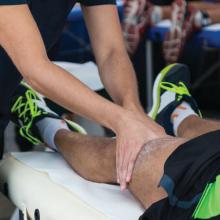SAN DIEGO – When it comes to soft tissue recovery modalities for elite athletes beyond rest, recovery, and retaining movement efficiency, not all options are created equal.
In fact, the science for most supplemental recovery modalities stems from cohort studies examining physiologic response – not high-level randomized clinical trials, Chuck Thigpen, PhD, said at the annual meeting of the American Orthopaedic Society for Sports Medicine.
“We should be very careful when we discuss overtraining and overload,” said Dr. Thigpen, senior director of practice innovation and analytics for ATI Physical Therapy, Greenville, S.C. “In fact, we need training load to create an anabolic response, so then the question is, how do we manage that load? I would suggest that it’s not overtraining, but underrecovery after a load that results in increasing fatigue, decreased performance, and potential increased injury risk.”
One option for soft tissue recovery is whole body vibration, for which the athlete stands, sits, or lies on a machine with a vibrating platform, while he or she performs static or isotonic exercise. “With this modality, you get a rapid co-contraction of muscle, which increases muscle preactivation,” said Dr. Thigpen, who is also directs the program in observational clinical research in orthopedics at the Greenville, S.C.–based Center for Effectiveness Research in Orthopaedics. “It has demonstrated increased blood flow as well as increased motor neuron excitability. There seems to be some physiologic benefit coming potentially from muscle waste removal (lactate) and nutrient delivery, as well as decreasing subsequent inhibition.”
In terms of parameters, benefits have been observed when athletes perform one or two sets of a static stretch or contact massage on a body vibration machine for a minute or so at a frequency of 30-50 Hz. “The application is what becomes challenging,” Dr. Thigpen said. “Where are you going to work this in? Is it a pre or post activity? Recent evidence implicates use during halftime may maintain strength and power. However, most of the work that has been done with vibration has been as an adjunct to exercise and not really in terms of recovery.”
Massage is another popular recovery tool, and most elite sports team have a masseuse on staff. Soft tissue manipulation creates release of oxytocin and other neurotransmitters, some central nervous system response, and increased blood flow to the treated area, but it also influences the athlete’s general disposition.
“There’s something about laying hands on somebody that seems to affect a person’s mood state,” Dr. Thigpen said. “Some studies have reported better perceived recovery status, even though the physiologic markers are about the same. Therefore, I would classify body vibration and massage in the same bucket. They seem to work; they seem to have some perceived benefit.”
Another soft tissue recovery option, compression therapy, has been shown to increase the local pressure gradient of the impacted area, thereby increasing progressive venous return and creating some muscle splinting (or protective muscle spasms). “,” Dr. Thigpen said. “A couple of studies have looked at the ultrastructure of the muscle concurrently after using compression garments. The nice thing is that you can put them on right after the activity. They should be worn for 24 hours.”
Another way to get compression therapy is to use compression devices; it is recommended that they are worn for 15-minute intervals for up to 4 hours after intense physical activity, depending on the device. “You see some of the same benefits that you see with compression garments,” he said.
Dr. Thigpen went on to discuss cryotherapy such as cold-water immersion in a tub, which has a long history of use in muscle recovery. In fact, many basic science studies have demonstrated a reduction of inflammatory markers and other immunologic responses after its use. “Cryotherapy is thought to create an acute decrease in blood flow and a concurrent increase in blood flow after you remove it, which creates the release of these neurotransmitters and immunosuppressants that seem to be helpful in the healing process,” he explained.
“The thought is, because of the decreased pain reduction, the waste removal, and the change in oxidative stress, this would be beneficial.” For example, cold water immersion in a tub four times over a 72-hour period has been found to decrease soreness and increase athletic performance on the backside. “That seems to be helpful in recovery, as an adjunct to heavy resistance training or eccentric and plyometric training,” he said.
Neuromuscular electrical stimulation has been shown to provide some analgesic effect to sore muscles via afferent stimulation, but the primary mechanism is contractile via the motor unit. Typically, neuromuscular electrical stimulation consists of about a 20-minute application to affected muscles, “and you can do multiple applications per day interspersed with periods of high-intensity training to restore the neuromuscular profile during the recovery period,” Dr. Thigpen said.
He reported having no financial disclosures.



